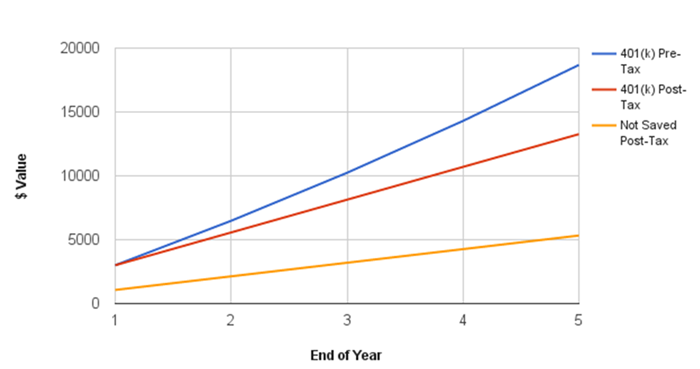Many of us feel like we should save more money, but lack the will to do so. Perhaps the lure of free money can help with that.
Employers often offer a 401(k) matching contribution. Sometimes it can be dollar for dollar up to a certain amount; sometimes it's some percentage up to a certain amount; sometimes it vests over time and depends on how long you have been with your employer.
Regardless, it's free money, simply stated. If you're not contributing at least the amount your employer matches to your 401(k), you're passing on free money.
But it is actually even worse than that. Let's say you make $50,000 per year, and your employer offers a dollar-for-dollar match on the first 3% of your income. That would mean your contribution would be $1,500, and your employer's would also be $1,500.
If you choose not to contribute, you're of course missing out on the employer match. But you're also missing out on the compound growth of the value of your contribution--and the matching contribution--as an investment.
Consider that $1,500 annually over a five-year time period. If you choose not to contribute, that's about $1,065 in take-home pay (assuming the 25% tax bracket in 2016) that you can spend. Not accounting for inflation, that tallies up to $5,325 to do with what you like.
Now consider investing that money--and the matching funds, which you would not otherwise get--with an average annual 8% return starting with the second year. Over five years, those funds could grow to more than $18,680, pre-tax. After tax, again assuming (years later, at retirement) the 25% tax bracket, it's still $13,263. We generated the graph below using our free financial planning tools.
You Can't Afford Not To Take Advantage of Your Employer Match

Graph assumes 25% tax bracket ($5,184 + 25% of the amount over $37,650 in 2016) and 8% annual return except for first year, which assumes 0% return.
A common reason people give for eschewing participation in their 401(k) is, "I can't afford it. I need the money now." Keep in mind, though, that it's not the full pre-tax salary you would be without--it's the post-tax salary. So it should be some consolation that, in the above example, you would not have a $1,500-sized hole in your take-home pay each year, but only a $1,065-sized hole.
Finally, in the high-class problem department: If you're fortunate enough to be able to sock away the maximum amount allowed to your 401(k) ($18,000 in 2016, or $24,000 if you're 50 or older), it makes sense to take a few moments to make sure you're spreading out that contribution over the course of the year to maximize the employer match. Otherwise, if you load up on your contributions at the beginning of the year, you may not get the full benefit of the match. There are calculators like this one to help you maximize the match.
In most cases, it's a good idea to contribute to a 401(k) far more than just what our employer matches. But saving at least that much should be considered the bare minimum.
WealthTrace can help you find out the effect of saving more money--in your 401(k) or elsewhere--on your retirement plans. A little can go a long way. Learn more:
https://www.mywealthtrace.com/how-it-works-individuals